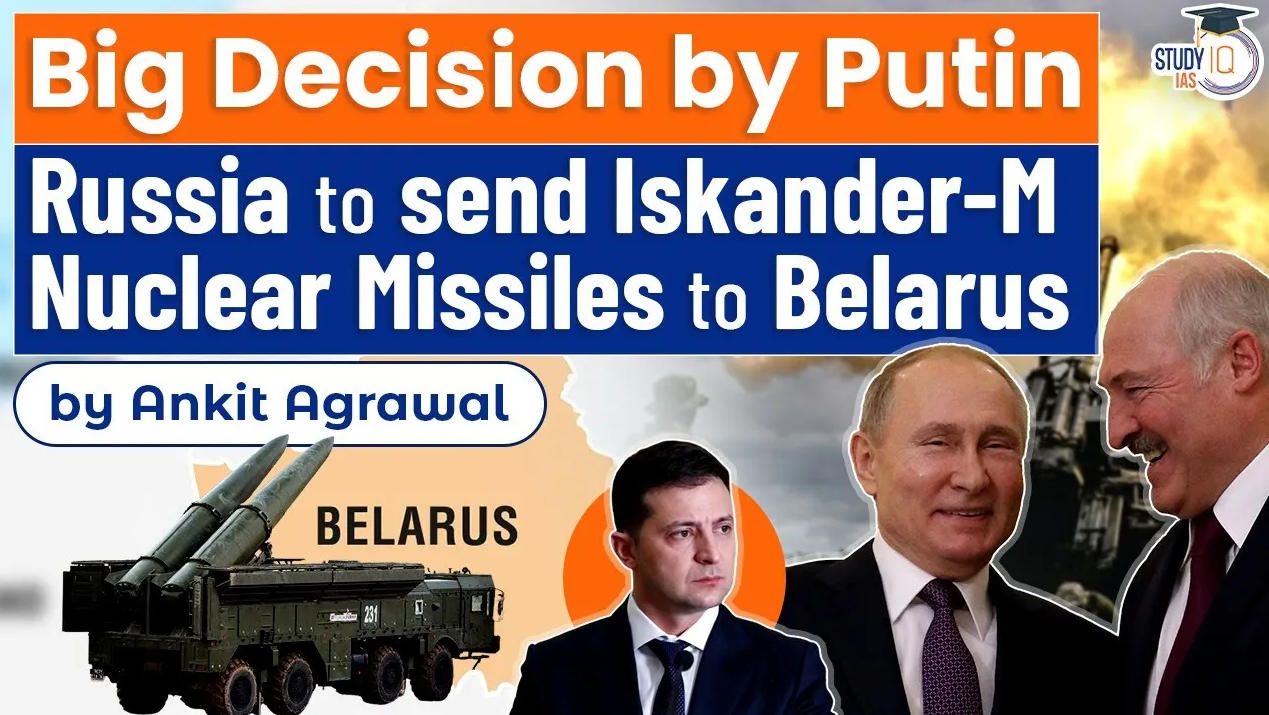Table of Contents
What has happened?
- Russia has promised its ally Belarus delivery of nuclear- capable missiles in the coming months to take on an “aggressive” West.
- Russian President Vladimir Putin made the announcement as Belarusian leader Alexander Lukashenko arrived in Moscow.
- In a televised broadcast, Putin said: “In the coming months, we will transfer to Belarus Iskander-M tactical missile systems, which can use ballistic or cruise missiles, in their conventional and nuclear versions.”
What is Iskander-M missile system?
- Codenamed “SS-26 Stone” by NATO, Iskander-M is a term used by Russia to define both the transporter-erector launch system and the short-range ballistic missile (SRBM) it fires.
- The system can also fire ground-launched cruise missiles (GLCMs) – the SSC-7 and the SSC-8.
- The Iskander-M system has been exclusively used by the Russian military, whereas Iskander-E is the one meant for export.
Capability and range
- The Iskander-M missile has a range of 500 km and it can carry a payload of up to 700 kg.
- It is capable of carrying both conventional and nuclear warheads.
- The conventional warheads can be equipped with include cluster bombs, electromagnetic pulse (EMP) warheads and bunker-buster munitions, according to US-based Missile Defence
- Advocacy Alliance (MDAA).
- The export variant, Iskander-E, has a range of 280 km with a reduced 480 kg payload.
When was it inducted?
- While the Iskander system was inducted by Russia in 2006, its development picked pace in the late 1980s after the “Oka” SRBM or the OTR-23 was banned under the Intermediate Nuclear Forces Treaty.
- The Oka was Russia’s first attempt to replace the Soviet Scud missiles.
- Iskander was the second. Russia first used the Iskander in combat in Georgia in 2008.

- On August 8, 2008, Russian forces began the invasion of Georgia, Marking the start of Europe’s first twenty-first century war.
Why Russia is doing this?
- It is one more time that Putin has raised nuclear weapons as a sort of warning to the West against climbing the escalation ladder in the Ukraine war.
- In the past too, Russia has used the Iskander system to project power against Europe, more so because of its ability to be fitted with tactical nuclear warheads.
- In 2012, Moscow said that the weapon could be used to target Europe’s missile defences.
- The Iskander system has already been deployed in Kaliningrad, a Russian exclave, from where it can be fired to target NATO forces in Poland, the Baltic States, and Sweden.


- Russia has made the announcement at the time when the G-7 meets in Germany.
- With its economy already under huge pressure from Western sanctions against banks, energy companies, airlines, high-tech and consumer goods, the choking off of the gold market will have a significant impact, according to G7 officials.
- Given London’s central role in the international gold trade, “this measure will have global reach, shutting the commodity out of formal international markets,” Britain said.
- “Gold, after energy, is the second largest export for Russia and a source of significant revenue for (President Vladimir) Putin and Russia,” the US official said,
- Adding that the blocking of Moscow’s gold sector “will further isolate Russia from the global economy.“
- The attempt to clamp down on Russian gold is likely to be the most meaningful economic measure against Moscow announced at the G7’s three-day meeting.
- Gold is also a refuge commodity in times of turmoil.
- Russian oligarchs are believed to have rushed to hide their assets from Western sanctions enforcers by converting to the precious metal.

Q) Which of the following is NOT a part of Indias money market?
- Indian Gold council
- Banks
- Call money market
- Bill market
Latest Burning Issues | Free PDF


























 WhatsApp
WhatsApp